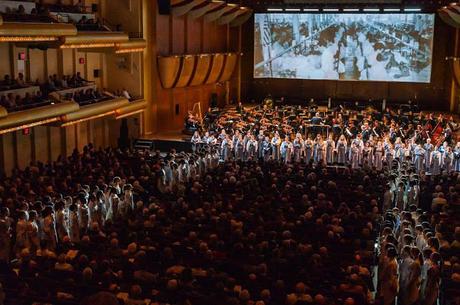by Paul J. Pelkonen

The premiere of Fire in my mouth with the Young People's Chorus of New York (left and right)
the singers of The Crossing (center) and the New York Philharmonic under the baton of Jaap van Zweden.
Photo © 2019 The New York Philharmonic.
Written for large orchestra, women's chorus and a 100-strong children's choir, Fire chronicles the Triangle Shirtwaist Factory Fire of 1911, in which 136 garment workers lost their lives in Greenwich Village. It is in four movements. Ms. Wolfe tracks the journey of these workers as immigrants across the Atlantic Ocean, their arrival in America, the joys and labors of the factory floor and the fire itself, which was the largest total of civilian casualties in New York history before the events of September 11, 2001.
Ms. Wolfe placed an emphasis on singing in each movement of the work, using small musical cell ideas stacked and racked to form vast, arching towers of sound. In the first movement, ideas would repeat, extend themselves and develop, repeating again with more weight each time. The orchestra's responsibility was to provide driving pulse to the singers, first the women of Philadelphia contemporary ensemble The Crossing, who started at the back of the stage under the vast projecting screen.
In the second section, "Factory", industrial sounds were added. The clicking and clattering of sewing machines were a constant, sampled presence under the music. They were augmented by the strings, playing col legno (with the back of the bow) and the churning pulse of double basses. Perhaps the signature moment here was the addition of scissors to the sound, held up and scythed in unison, the blades brought a feeling of menace to the workers' oppressive conditions.
The children's chorus (The Young People’s Chorus of New York City) made the most dramatic entrance of the night. Clad in white, they marched in troops down the aisles of David Geffen Hall. At first they sang simple syllables, creating a spatial effect. Then at Jaap van Zweden's cue, the singers erupted in a fount of "protest", showing the problems of working conditions and the plight of the workers. A sense of tension and dread built throughout the night, with the fires ready to erupt.
The last movement, "Fire" evokes some of the darkness and terror of Shostakovich (I was reminded of the "Tocsin" from the Eleventh Symphony) with the singers' cries of alarm creating an uncomfortable experience. The movement ended with a quiet, elegiac passage, a reading of the names of the dead by the choristers. As the names appeared, ghostlike on the huge projection screen over the stage, one was reminded of the rituals of September 11.
This was not the only work on the program. The concert started with a powerful, muscular reading of Elegy by Stephen Stucky. This was drawn from the composer's oratorio August 4, 1964, mourning murdered civil rights workers. It was followed by the one joyous work of the evening, an engaging performance of Aaron Copland's playful, jazzy and evergreen Clarinet Concerto. Anthony McGill proved an able and entertaining soloist, and Mr. van Zweden led this work's complex textures with a lightness that one does not always associate with his presence on the podium.
If you enjoyed this article, it's time to click over to Superconductor's Patreon page, and help support the cost of independent music journalism in New York City at the low cost of just $5/month.

